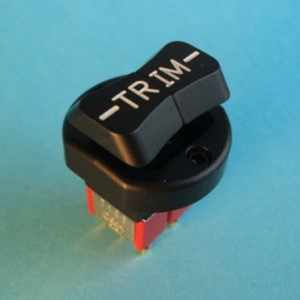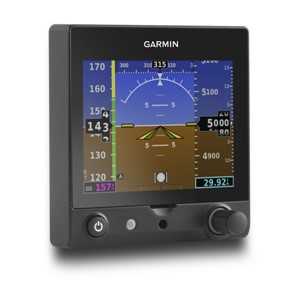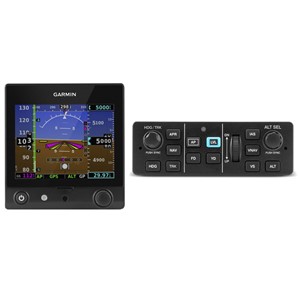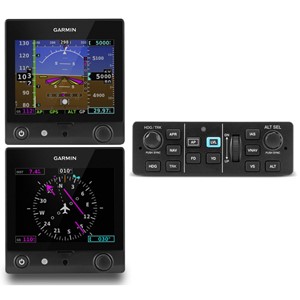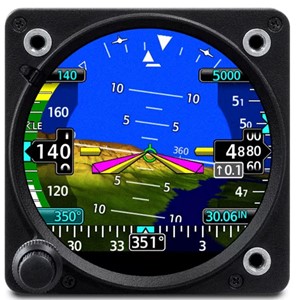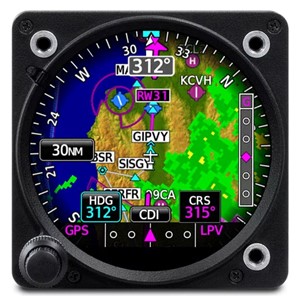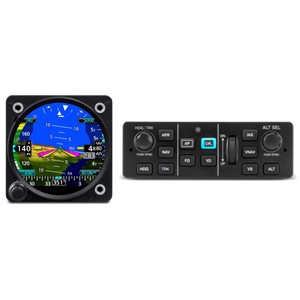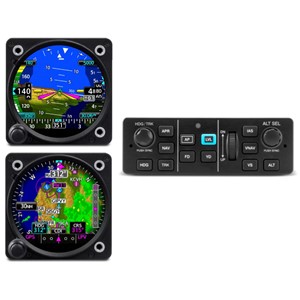It’s the Autopilot Solution GA Aircraft Owners Have Been Waiting For
- Cost-effective, precise and smooth in-flight characteristics, built-in self-monitoring capabilities and lower cost of ownership when compared to older autopilot systems
- Designed for existing light single-engine piston, fixed-wing aircraft, initially planned to be available for the Cessna 172, Cessna 182 and Piper PA-28
- Leverages certificated G5 electronic flight instrument1 for primary attitude reference — plus input and display of altitude preselect, heading, vertical speed, airspeed target and flight director cues
- Robust feature set, including safety features such as underspeed and overspeed protection, a dedicated return-to-level (LVL) mode button, Garmin ESP™ (Electronic Stability and Protection), Flight Director (FD), coupled approaches and missed approaches when paired with a compatible navigator and much more
- Offers 2-axis (pitch and roll) capabilities tailored to your aircraft; optional pitch-trim servo adds automatic trim and manual electric trim
The revolutionary GFC 500 autopilot brings unprecededented levels of capability, reliability and affordability to light single-engine, fixed-wing general aviation aircraft. GFC 500 leverages Garmin's advanced attitude-based flight control technology developed for the popular GFC 700 autopilot, which drives their most advanced glass flight deck systems.
To help prevent incidents caused by loss of control, the FAA and other regulators encourage the use of key technologies, such as angle-of-attack indicators and autopilots, to help increase situational awareness, reduce pilot workload and enhance safety of flight. GFC 500 is the right product — at the right price — for popular certified light GA aircraft such as select Cessna 172 and Cessna 182 models as well as Piper PA-28 series aircraft. Boasting a superior feature set, GFC 500 incorporates a number of safety-enhancing technologies, including Garmin ESP, underspeed and overspeed protection, automatic LVL mode, flight director (FD) command cues and more.
.jpg)
Smart Technology, Easily Accessible
Drawing on top-end Garmin flight control technology from our GFC 700, GFC 500 provides crisp, precise response and optimum performance over the entire airspeed envelope of your aircrcaft. Rather than depending on failure-prone mechanical gyros, the GFC 500 system is digitally controlled, using solid-state attitude and air data sensor reference — giving you ultra-smooth roundouts, intercepts and more while also enhancing the reliability of the system. Incorporating our crisp, easy-to-read 3.5” G5 electronic flight instrument1, a mode controller and 2 “smart” servos, the autopilot’s architecture supports full pitch-and-roll axis control capabilities as well as optional pitch trim and manual electric trim with an additional servo.
With the optional GAD™ 29 nav data adapter, GFC 500 will interface with the GTN™ 650 and GTN 750 and legacy GNS™ 430 and GNS 530 (WAAS and non-WAAS) series navigators to fly a wide range of precision, nonprecision and GPS-guided approaches as well as holds, procedure turns, missed approaches and more. GFC 500 also includes built-in GPS roll steering capability, which allows smoother navigation tracking and eliminates the need for external roll steering converters. Flight director cues are displayed as command bars on the G5 electronic flight instrument. The command bars are always in view when the autopilot is doing the flying — and may also be used for visual guidance when you’re hand-flying the aircraft. With support for a remotely installed Takeoff/Go-around (TOGA) button, the flight director can be cued to automatically indicate and capture the correct pitch attitude required to fly a missed approach and then follow the missed approach procedure loaded in your compatible GPS navigator. Up to 2 G5 electronic flight instruments can be interfaced with the GFC 500 autopilot in your aircraft, providing full reversionary display capability.
Mode Control at Your Fingertips
A mode controller is included with your GFC 500 package, and its compact size and mark-width design require only minimal space in your avionics stack while providing easy access to all autopilot modes and functions. You can select advanced lateral and vertical modes such as pitch hold, altitude preselect, altitude hold, vertical speed and indicated airspeed hold as well as roll, track and selected heading. An intuitive control wheel integrated into the GFC 500 mode controller allows for easy and precise pitch, vertical speed and airspeed adjustments, while separate knobs allow quick twist control of heading and altitude. For added safety, a dedicated LVL button on the controller lets you command the autopilot to automatically return your aircraft to straight-and-level flight — and thus help avert a potential loss-of-control situation.
 Silky-smooth Servo Control
Silky-smooth Servo Control
For maximum reliability and safety, the GFC 500 servos incorporate brushless DC motors and a gear train that eliminates the need for a mechanical slip clutch and shear pins. This design results in enhanced system efficiency — while also reducing maintenance/inspection requirements. The servos also provide virtually no control system friction with the autopilot turned off, decoupling the motor drives so you can easily hand-fly or override the system without fighting the controls. The servos weigh only 1.4 lbs each, making them more than 40% lighter than most other autopilot servos of their class. Each servo is operated by its own built-in microprocessor, which provides the “smart” logic to significantly improve sensor performance, response and self-monitoring capabilities — while simplifying overall system configuration and installation.
Hand-fly with Stability Protection
Any pilot who’s ever been startled to attention by a stall warning horn in a busy cockpit will appreciate the proactive stability augmentation of our ESP technology, which is standard on the GFC 500 system. When the aircraft is being hand-flown, this ESP feature functions independently of the autopilot — although it uses the same control servos — to nudge the controls toward stable flight whenever pitch or roll deviations exceed the recommended limits or underspeed/overspeed conditions occur. In the event of pilot incapacitation, after the system detects that it has been activated for a specified period of time, the autopilot will engage with the flight director in level mode, bringing the aircraft back to level flight and helping to avoid the onset of inadvertent stall/spins, steep spirals or other loss-of-control scenarios. Additionally, ESP can be manually disabled to allow for intentional flight maneuvers.
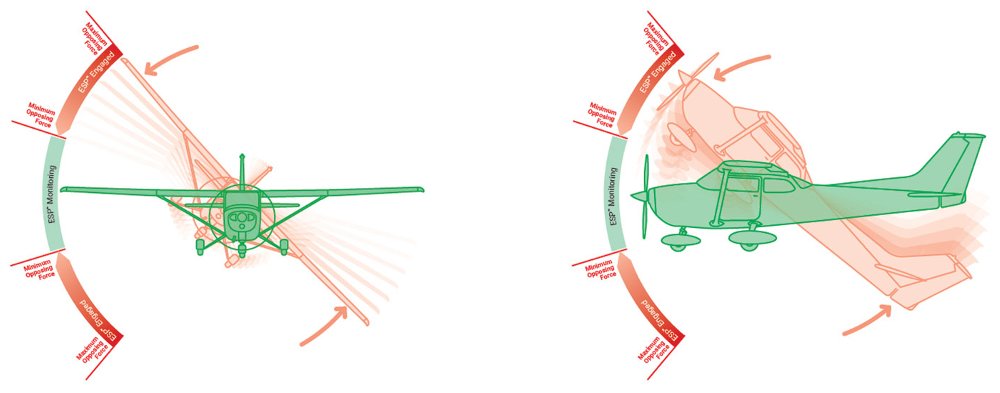
An Autopilot Knows Its Limits
With the autopilot engaged, GFC 500 also provides overspeed and underspeed protection. In a high airspeed situation — for example, if you’re descending and your aircraft is approaching VNE or VMO — the system will increase the aircraft’s pitch attitude, preventing a further increase in airspeed and potential structural damage. Likewise, at the other end of the speed spectrum, GFC 500 provides underspeed (stall) protection. For example, in the event the pilot does not immediately advance the throttle to full power, with the autopilot engaged while flying a missed approach sequence, the autopilot will help prevent an aircraft stall by reducing pitch attitude and provide the pilot with an “airspeed, airspeed” audible alert.
It’s a Total Peace-of-mind Investment
There is no substitute for a safe and vigilant pilot. But there are times when a “helping hand” at the controls can have a significant impact on the safety, comfort and enjoyment of your flight. Backed by a comprehensive warranty and the industry’s No. 1-rated product support team, our GFC 500 autopilot system is a price- and peace-of-mind breakthrough for pilots who want to add these valuable capabilities to their existing light piston GA aircraft. Installation approval via supplemental type certification (STC) is expected to be completed on a range of popular models. See your authorized Garmin installation center for more details on configuring a GFC 500 retrofit package for your aircraft.
1Required. G5 sold separately.
In addition to traditional autopilot capabilities such as altitude hold, vertical speed and heading, GFC 600 and GFC 500 also include the following features:
- Premium functions and advanced capabilities such as altitude pre-select1 and indicated airspeed hold mode; VNAV will be a growth function when appropriately equipped
- Pilots can select, couple and fly various instrument approaches, including GPS, ILS, VOR, LOC and back course approaches2,3
- Built-in GPS roll steering capability eliminates the need for external roll steering converters for smoother navigation tracking when installed with a compatible navigator
- Level Mode button, which automatically engages the autopilot to restore the aircraft to straight-and-level flight
- Underspeed protection helps prevent the pilot from stalling the aircraft if the autopilot is engaged in an inappropriate manner
- Overspeed protection helps prevent the pilot from exceeding aircraft maximum speed (VNE) if the autopilot is engaged in an appropriate manner
- With the addition of an optional yaw servo, Yaw Damping (YD) mode minimizes yawing oscillations while also helping to maintain coordinated flight by keeping the slip/skid indicator centered
- Flight Director command bars can be displayed on G5 with the GFC 500, while GFC 600 displays Flight Director on a variety of flight displays, such as G500 and G600
- Pilots can fly coupled ‘go-arounds’ during missed approach sequencing. A remotely-installed go-around button commands the Flight Director to display the appropriate pitch attitude required for the missed approach procedure and activates a loaded missed approach when paired with a GTN™ 650/750 navigator
- An optional pitch-trim servo adds automatic trim and manual electric trim
- Control wheel steering is available on GFC 600, which allows the pilot to adjust pitch, roll, altitude hold, vertical speed or airspeed references using the control yoke
2 GFC 500 requires a GTN™/GNS™ navigator or GNC® 255/SL 30 for navigation and approach functions.
3 GFC 600 requires an external navigator for navigation and approach functions; see installation manual for additionalcompatibility information.
- GMC 507
- GSA 28 servos (2 or 3)
- STC Install Kits
- Product Info Kit
Note that the G5 Electronic Flight Instrument or GI 275 is required for use with the GFC 500, and sold separately if not already installed in the aircraft.


